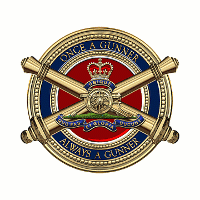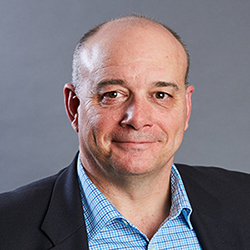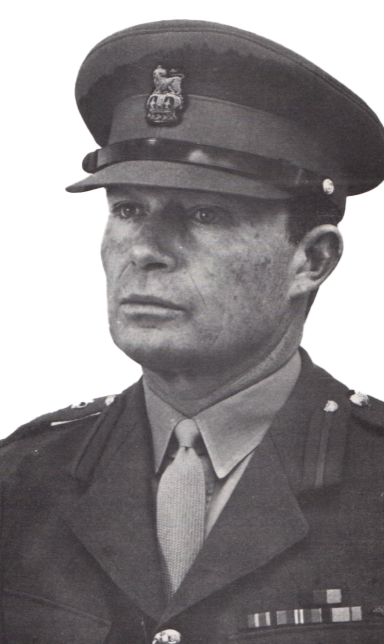In the post-war Army, Captain Bogle became an instructor at RMC before attending a Long Gunnery Staff Course in the UK. On return to Australia he was promoted major and took up the appointment of Brigade Major at HQ RAA 3rd Division in Melbourne.
When the National Service scheme of the 1950s spawned HQ 5th Army Group Royal Artillery (Field) in 1952, Bogle became its Brigade Major in Brisbane. In 1955, Australia agreed to commit ground forces to the Malayan Emergency and Bruce Bogle was chosen to raise M (for Malaya) Field Battery which became the 105th Field Battery on 1 July 1955. In three months, he trained and equipped a rather disparate group of gunners and led them to war.
On 1 January 1956, Major Bogle fired the first RAA round in anger since the Second World War. Though the Malayan Emergency was predominantly a gun troop war, no one was in any doubt who was the 105th Battery=s commander. His war diary is a credit to detailed staff work and provides a marvellous record of the unit's tour of duty. Under his command, the battery not only survived the intimate inspections of British administrators, but was described as the best administered unit in the brigade group by its commander. On the other hand, the brigadier thanked the 105th for its rapid and flexible support ... always given. Bogle was Mentioned in Despatches for this most professional and dutiful service which ended in October 1957.
Back in Australia, Bruce became an Instructor in Gunnery at the School of Artillery till promoted lieutenant colonel and appointed Staff Officer Royal Artillery Grade One (SORA 1) at HQ Southern Command in Melbourne in mid 1958.
Lieutenant Colonel Bogle again packed his family off to England where he attended the British Joint Services Staff College (JSSC) in 1960B61 and was then appointed to the College's directing staff. The Bogle family was quartered in the beautiful surroundings of Latimer House, near Chesham in Buckinghamshire. All this staff training led him back to Canberra in 1963 for the next four yearsC SORA 1 in the Directorate of Artillery, General Staff Officer Grade One in the Directorate of Staff Duties, then promoted colonel and served as the Director of Equipment Procurement.
Colonel Bogle's forte in training next saw his appointment as Commandant of the Officer Cadet School at Portsea, Victoria, followed by promotion to brigadier and a move across Port Phillip Bay to Commandant of the Australian Staff College at Queenscliff in 1969.
Brigadier Bogle spent his last three years of service back in Canberra. He worked on Major General AL MacDonald's staff as the Director of Military Requirements and resigned in 1975 at 53 years of age.Brigadier Bogle spent his last three years of service back in Canberra. He worked on Major General AL MacDonald's staff as the Director of Military Requirements and resigned in 1975 at 53 years of age.
In retirement, Bruce returned to England and settled at Hawcombe House, Porlock, West Somerset. There he remained apart from an interlude in Minehead until last year when he suffered a stroke following a cancer operation and was moved to Eastleigh Care Home in Minehead. There he passed away on 11 May 2012 a few weeks after his 90th birthday, which he had happily celebrated surrounded by his immediate family.
He is the honorary historian for the 105th Battery, I corresponded with Brigadier Bogle periodically over the last 20 years and always found him the perfect English gentleman. It was always by letter as I believe he abhorred computers. When we first formed the 105th Battery Association, I wrote inviting him to be our patron. He replied politely saying that he had never been a member of an all ranks association so would respectfully decline this offer. Even his last letter to me after I had forwarded details of his father-in-law's service with the 105th began Dear Colonel.
The brigadier is survived by this widow, Susan still living at Eastleigh Home, Minehead, and three sons: James, a barrister of the Inner Temple and a former colonel in the British reserve forces; David, a professor of chemical engineering and Head of the Graduate School at the University College, London; and Angus, a portfolio manager with Fidelity (UK) plc, the world's largest fund manager. All three are married and there are four grand-daughters.
Son James organised a full military funeral in the Porlock Parish Church of St Dubricius with buglers, choir and a piper. Mourners followed the hearse and piper through the streets of Porlock to the grave side, not far from Hawcombe House. The casket was adorned with a silver sword, hat, gloves and the brigadier's medals. When the bugles had sounded Last Post and Sunset and the last strains of Flowers of the Forest, the Scottish lament for the dead faded from the pipes, mourners walked up the Combe to Glen Lodge for a final reception. It was a fitting farewell.
Vale Brigadier Bruce Lockhart BogleCofficer, gentleman, exceptional trainer and the one who re-raised and led the 105th Field Battery to war. Called to that Great Gun Park up above to raise the standards of fellow Gunners.
(Photo courtesy Colin Cunningham, editing by James Bogle) |








